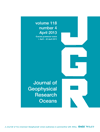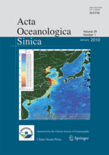
Physical Oceanography
Scope & Guideline
Unveiling the Mysteries Beneath the Waves
Introduction
Aims and Scopes
- Ocean Dynamics and Circulation:
Research on wind-driven ocean circulation models and their boundary conditions, exploring physical processes and implications for coastal and marine environments. - Geophysical Techniques and Applications:
Utilization of advanced geophysical methods such as seismic inversion, GNSS data analysis, and gravity modeling to investigate subsurface structures and processes. - Environmental Monitoring and Assessment:
Studies that employ geophysical and remote sensing techniques to monitor environmental changes, such as landslides, droughts, and hydrothermal alterations. - Geological and Tectonic Investigations:
Examination of geological structures and tectonic events through geophysical data, contributing to the understanding of seismic risks and earth dynamics. - Innovative Methodologies in Geophysics:
Development of new analytical approaches, including machine learning and optimization techniques, to enhance the accuracy and efficiency of geophysical data interpretation.
Trending and Emerging
- Machine Learning and AI in Geophysics:
An increase in the application of machine learning techniques for data analysis and interpretation indicates a growing trend towards using artificial intelligence to enhance geophysical research. - Climate Change and Environmental Impact Studies:
Recent papers emphasize the impact of climate change on ocean dynamics and environmental conditions, reflecting a rising interest in sustainability and ecological assessments. - Integrated Geophysical Studies:
There is a notable trend towards integrating multiple geophysical techniques to provide a more comprehensive understanding of geological and oceanographic phenomena. - Real-time Monitoring Technologies:
Emerging themes include the use of GNSS and other real-time monitoring technologies to assess and respond to geophysical hazards, indicating a shift towards proactive rather than reactive research. - Geophysical Data Fusion:
Research increasingly focuses on the fusion of various geophysical data types to improve modeling accuracy and understanding of complex geological systems.
Declining or Waning
- Historical Seismic Events:
There has been a noticeable decrease in papers focused on historical seismic events and their analysis, suggesting a shift towards contemporary seismicity and real-time monitoring. - Traditional Geological Methods:
The reliance on classical geological analysis methods appears to be waning, with fewer studies published that do not integrate advanced geophysical or computational techniques. - Localized Case Studies:
Research focusing solely on localized geological case studies without broader implications or methodologies has become less prominent, as the journal shifts towards more comprehensive and integrative studies.
Similar Journals

CHINESE JOURNAL OF GEOPHYSICS-CHINESE EDITION
Exploring the Depths of Earth Science InnovationCHINESE JOURNAL OF GEOPHYSICS-CHINESE EDITION, published by SCIENCE PRESS, stands as a prominent platform for the dissemination of cutting-edge research in the fields of Geophysics and Geochemistry. Since its inception in 1979, this esteemed journal has successfully converged a wealth of knowledge, boasting a substantial impact factor and a recognized standing within the academic community, evidenced by its Q2 categorization in both Geochemistry and Petrology and Geophysics as of 2023. Researchers, professionals, and students looking to stay abreast of the latest advancements in solid-earth sciences will find the journal's comprehensive articles and studies invaluable. Based in Beijing, China, the journal emphasizes a broad scope, encompassing various aspects of geophysical research and methodologies. Although it does not currently offer open access options, its commitment to quality research makes it a crucial resource for the scientific community.

JOURNAL OF GEOPHYSICAL RESEARCH-OCEANS
Exploring the Depths of Oceanic DiscoveryJournal of Geophysical Research-Oceans is a premier interdisciplinary journal published by the American Geophysical Union, focused on the dynamic field of ocean sciences. With a rich history dating back to 1986, this journal has become a pivotal platform for researchers, providing a wealth of data and innovative insights into oceanographic processes and their essential role within the Earth's system. The journal enjoys an impressive impact factor and consistently ranks in the Q1 quartile across numerous categories, including Earth and Planetary Sciences and Oceanography, making it a respected source for cutting-edge research and reviews. Notably, it holds significant positions within Scopus rankings, further emphasizing its importance in shaping the scientific discourse surrounding oceanic phenomena. While available through subscription, the Journal of Geophysical Research-Oceans remains an invaluable resource for academics, industry professionals, and students eager to deepen their understanding of ocean dynamics and geophysical interactions.

Journal of Operational Oceanography
Transforming Data into Insight for Sustainable OceansThe Journal of Operational Oceanography, published by Taylor & Francis Ltd, stands as a pivotal platform within the field of oceanography, focusing on the integration of operational practices, technology, and scientific research. With a strong impact factor and a notable Q2 quartile ranking in the category of Earth and Planetary Sciences, this journal offers researchers, professionals, and students a vital resource for disseminating new knowledge and innovative methodologies related to ocean studies. Covering a range of topics from marine data analysis to the application of oceanographic principles in sustainable practices, the journal’s content is crucial for advancing understanding in this dynamic field. Operating since 2008 and continuing through 2024, it is dedicated to fostering collaboration and dialogue among the scientific community, ensuring accessibility to essential findings that drive informed decision-making in marine science. With its commitment to high-quality, peer-reviewed articles and a ranking in the top 10th percentile of its category, the Journal of Operational Oceanography is an indispensable resource for those looking to make significant contributions to marine research.

Ocean Science Journal
Exploring the Depths of Ocean KnowledgeOcean Science Journal, published by the Korea Institute of Ocean Science and Technology (KIOST), is a pivotal resource for scholars and practitioners in the field of oceanography. With the ISSN 1738-5261 and E-ISSN 2005-7172, this journal presents cutting-edge research from 2006 to 2024, bridging fundamental and applied ocean sciences. Based in South Korea, with its headquarters located in Busan, the journal has achieved a commendable Scopus rank of #72 out of 145 in the domain of Earth and Planetary Sciences, placing it in the 50th percentile among peer publications. Classified in the Q3 category of the 2023 Oceanography rankings, Ocean Science Journal offers a platform for innovative studies that advance understanding of marine environments and promote sustainable ocean practices. While it does not operate under an open access model, readers and contributors can expect high-quality, peer-reviewed material that addresses pressing oceanic challenges and developments. This journal serves as an essential tool for researchers, professionals, and students committed to fostering marine science and ocean technology.

ACTA OCEANOLOGICA SINICA
Diving Deep into Marine and Freshwater StudiesACTA OCEANOLOGICA SINICA, published by SPRINGER, stands as a significant voice in the fields of Aquatic Science and Oceanography, contributing vital research and insights since its inception in 1985. With an ISSN of 0253-505X and an E-ISSN of 1869-1099, this journal maintains a strong international focus, delivering high-quality peer-reviewed articles that address pressing marine and freshwater environmental issues. Although it operates under a subscription model, its Q3 ranking in both Aquatic Science and Oceanography demonstrates its solid standing within Scopus, placing it in the 48th and 44th percentiles respectively. The journal aims to foster knowledge exchange and collaboration among researchers, professionals, and students by providing a platform for innovative studies and comprehensive reviews. With a dedicated editorial board and a commitment to advancing scientific understanding, ACTA OCEANOLOGICA SINICA serves as an essential resource for anyone engaged in the study of oceanographic phenomena and aquatic ecosystems.

Geofizicheskiy Zhurnal-Geophysical Journal
Bridging Theory and Practice in Geophysical ScienceGeofizicheskiy Zhurnal-Geophysical Journal, published by the esteemed S I Subbotin Institute of Geophysics, National Academy of Sciences of Ukraine, stands as a vital resource for professionals and researchers in the field of geophysics. With an ISSN of 0203-3100 and an E-ISSN of 2524-1052, this journal is recognized for its rigorous peer-reviewed articles that delve into various aspects of geophysical research, including seismic studies, geodynamics, and Earth surface processes. Although currently not under an open access model, the journal maintains a commitment to disseminating high-quality research, thereby enriching the global geophysical community. The publication aims to foster collaboration and knowledge transfer among scientists and engineers while addressing complex geophysical challenges in a rapidly evolving landscape. By engaging with cutting-edge research, readers can expect to uncover insights that advance both theoretical understanding and practical applications in geophysical science.

OCEAN DYNAMICS
Charting New Waters in Ocean ResearchOCEAN DYNAMICS is a premier peer-reviewed journal published by Springer Heidelberg, dedicated to advancing the field of oceanography. With an ISSN of 1616-7341 and an E-ISSN of 1616-7228, the journal has established itself as a key resource for researchers and professionals interested in the dynamic processes of the world's oceans. As of 2023, it holds an impressive Q2 category ranking in Oceanography, placing it among the top journals in its field (Rank #34/145, 76th percentile in Earth and Planetary Sciences). Although operating under a traditional publishing model without open access options, OCEAN DYNAMICS continues to provide valuable insights and a platform for innovative research, boasting coverage from 2001 to 2024. Researchers and students alike will benefit from this journal's commitment to showcasing cutting-edge studies that enhance our understanding of oceanographic phenomena.

MARINE GEOPHYSICAL RESEARCH
Uncovering the geological secrets beneath the waves.MARINE GEOPHYSICAL RESEARCH is a prominent journal published by Springer, dedicated to advancing the field of marine geophysics, with significant contributions to geochemistry, petrology, and oceanography. Established in 1970 and currently running its volumes until 2024, this journal operates as a key resource for researchers and professionals focused on understanding the complexities of marine environments and geological processes. With a strong foothold in academic rankings—positioned in Q2 for both Geophysics and Oceanography, and Q3 for Geochemistry and Petrology in the 2023 category quartiles—MARINE GEOPHYSICAL RESEARCH provides a rigorous platform for high-quality research dissemination. Although not an open-access journal, it offers invaluable insights into marine geophysical phenomena, thus appealing to a diverse audience of scholars and practitioners. The journal’s relevance and impact are further underscored by its Scopus ranks, situating it competitively within the Earth and Planetary Sciences domain. Researchers and students seeking to stay abreast of cutting-edge developments and methodologies in marine geophysics will find it an essential addition to their academic resources.

Journal of Ocean University of China
Transforming Ocean Knowledge into Practical SolutionsThe Journal of Ocean University of China, ISSN 1672-5182, is a premier academic journal dedicated to advancing the fields of Ocean Engineering and Oceanography. Published by the esteemed Ocean University of China, the journal serves as a vital platform for researchers, professionals, and students to disseminate groundbreaking findings and foster collaboration in marine science and engineering. With a commitment to quality, the journal currently holds a Q3 ranking in both Ocean Engineering and Oceanography as of 2023, indicating its significant contributions within the scientific community. The journal's scope encompasses a wide range of topics including marine technology, ecological studies, and coastal management, all aimed at enhancing the understanding and utilization of oceanic resources. Although currently not Open Access, it continues to attract submissions from renowned scholars, ensuring a diverse and innovative range of research. By providing access to cutting-edge research and practical insights, the Journal of Ocean University of China plays a critical role in shaping the future of ocean sciences and engineering.

Ocean and Coastal Research
Advancing marine science for a sustainable future.Ocean and Coastal Research, published by the Institute Oceanográfico of the University of São Paulo, is an essential academic journal dedicated to advancing the fields of Aquatic Science, Oceanography, and Water Science and Technology. Established in 2020, the journal has quickly become a noteworthy platform contributing to the understanding and sustainable management of marine and coastal ecosystems, with an open access model that promotes the dissemination of critical research findings. Although currently categorized in the fourth quartile across its respective fields in 2023, the journal serves as an emerging repository of valuable insights for researchers, professionals, and students alike, aiming to make impactful discoveries that address contemporary challenges in ocean conservation and resource management. The journal's editorial team is committed to fostering interdisciplinary collaboration and upholding rigorous peer-review standards, thereby ensuring high-quality contributions that reflect the dynamic nature of marine science. With an E-ISSN of 2675-2824, all access to published articles is freely available, supporting global research efforts addressing crucial environmental issues.